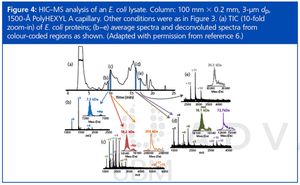
Recent advances in stationary phases for hydrophobic interaction chromatography (HIC) permit HIC–MS analysis of intact antibodies and other proteins using direct flow to the mass spectrometer.

Recent advances in stationary phases for hydrophobic interaction chromatography (HIC) permit HIC–MS analysis of intact antibodies and other proteins using direct flow to the mass spectrometer.

This is the third in a series of articles exploring topics that will be addressed at the HPLC 2016 conference in San Francisco, USA, from 19 to 24 June.

Until recently, mass spectrometry (MS) was limited in the information it could supply regarding proteins larger than 40 kDa. The most recent instruments have broken through that limit, but proteins smaller than 40 kDa are still more easily detected in MS and can suppress the collection of data from larger proteins. This situation has created a demand for better separation of proteins upstream from the MS orifice. At present, though, this separation of proteins is something of a bottleneck. Methods such as reversed-phase chromatography that involve mobile phases compatible with MS are not compatible with many proteins. Alternative modes of chromatography include size-exclusion chromatography, ion-exchange chromatography, hydrophilic interaction chromatography (HILIC), and hydrophobic interaction chromatography (HIC). We decided to take another look at HIC. This is the third in a series of articles exploring topics that will be addressed at the HPLC 2016 conference in San Francisco, from June 19 to 24.

Electrostatic effects superimposed on hydrophilic interactions enables selection or deselection of functional groups for compound isolation.

When electrostatic effects are superimposed on hydrophilic interactions, specific functional groups can be targeted.

Published: February 1st 2021 | Updated:

Published: April 8th 2016 | Updated:

Published: July 1st 2011 | Updated:

Published: January 1st 2011 | Updated:

Published: May 25th 2016 | Updated: